You are using an out of date browser. It may not display this or other websites correctly.
You should upgrade or use an alternative browser.
You should upgrade or use an alternative browser.
But how could we save MAVİ VATAN while our limited frigates would have to secure our Aircraft Carrier around the Africa or somewhere else?That goes beyond coastal.
Thinking in the context of being able to reserve naval assets to join aircraft carrier groups the remaing assets will still be able to defend coastal waters.
By the time we get the AC we can get enough of every ship and weapon to go along with it, we have a minimum 7 years to it.But how could we save MAVİ VATAN while our limited frigates would have to secure our Aircraft Carrier around the Africa or somewhere else?
And how did that work for us so far?
That's not how planning should work. We should think all aspects ahead of time. It has cost us many things, and may cost us a defeat
Ideally you are right. But it's like prosthetics that are made when there are no patients who need them.
The navy has plans since 1999 for aircraft carriers, did we build the battle group ahead? What did we do in that 25 years? A big nothing!
Last edited:
Khagan1923
Contributor
Don't understand the grand discussion here about if a AC is needed or not. You are talking about something that is 20+ years away. Until then who knows what will change.
The focus here should be on expanding the Navy. Right now we are replacing ship for ship, yes more capable but still. The Navy needs to be expanded. I truly hope they are not thinking about dropping the number of TF2000 they want from 8 to 4. Our shipyards are already hot, we need to take advantage of this and start planning a 4000-5000 ton Multi-Purpose frigate that can be started on right after the first batch of either TF2000 or in between the second batch of I-Class and the TF2000, though I don't expect there to be much wiggle room. The Navy surely will want the production on the TF2000 to start right after the second batch of I-Class is delivered to the Navy.
The focus here should be on expanding the Navy. Right now we are replacing ship for ship, yes more capable but still. The Navy needs to be expanded. I truly hope they are not thinking about dropping the number of TF2000 they want from 8 to 4. Our shipyards are already hot, we need to take advantage of this and start planning a 4000-5000 ton Multi-Purpose frigate that can be started on right after the first batch of either TF2000 or in between the second batch of I-Class and the TF2000, though I don't expect there to be much wiggle room. The Navy surely will want the production on the TF2000 to start right after the second batch of I-Class is delivered to the Navy.
The US guys at The War Zone posted an article about Türkiye's new Istanbul-class light frigate (and TCG Derya, USV, Turkish naval defense industry outlook).
By Oliver Parken| PUBLISHED Jan 23, 2024 8:34 PM EST

On January 19, Turkey's first-in-class frigate TCG Istanbul entered into service with the country's Navy during a ceremony held at Sefine Shipyard in Yalova Province, northwest Turkey. The introduction of the vessel marks a significant moment for the country, given that it constitutes Turkey's first nationally-developed frigate. This also comes amid a relatively remarkable modernization effort based on locally sourced hardware that spans the services within Turkey's armed forces in recent years.
The Istanbul class is designed to perform a wide range of missions for the Turkish Navy, including everything from surveillance to anti-surface, anti-air, and anti-submarine warfare. What's most notable about TCG Istanbul in particular is its high percentage of indigenously built components, particularly in terms of its armament and electronic warfare and sensor suites. In all, some 220 Turkish companies participated in constructing the frigate, which included 80 subcontractors working on the delivery of more than 150 systems, Naval News reports.
In attendance for the ceremony was Turkish President Recep Tayyip Erdogan, as well as a number of high-profile guests including Turkey's Minister of National Defense, Yaşar Güler, and Admiral Ercüment Tatlıoğlu, commander of the Turkish Naval Forces.
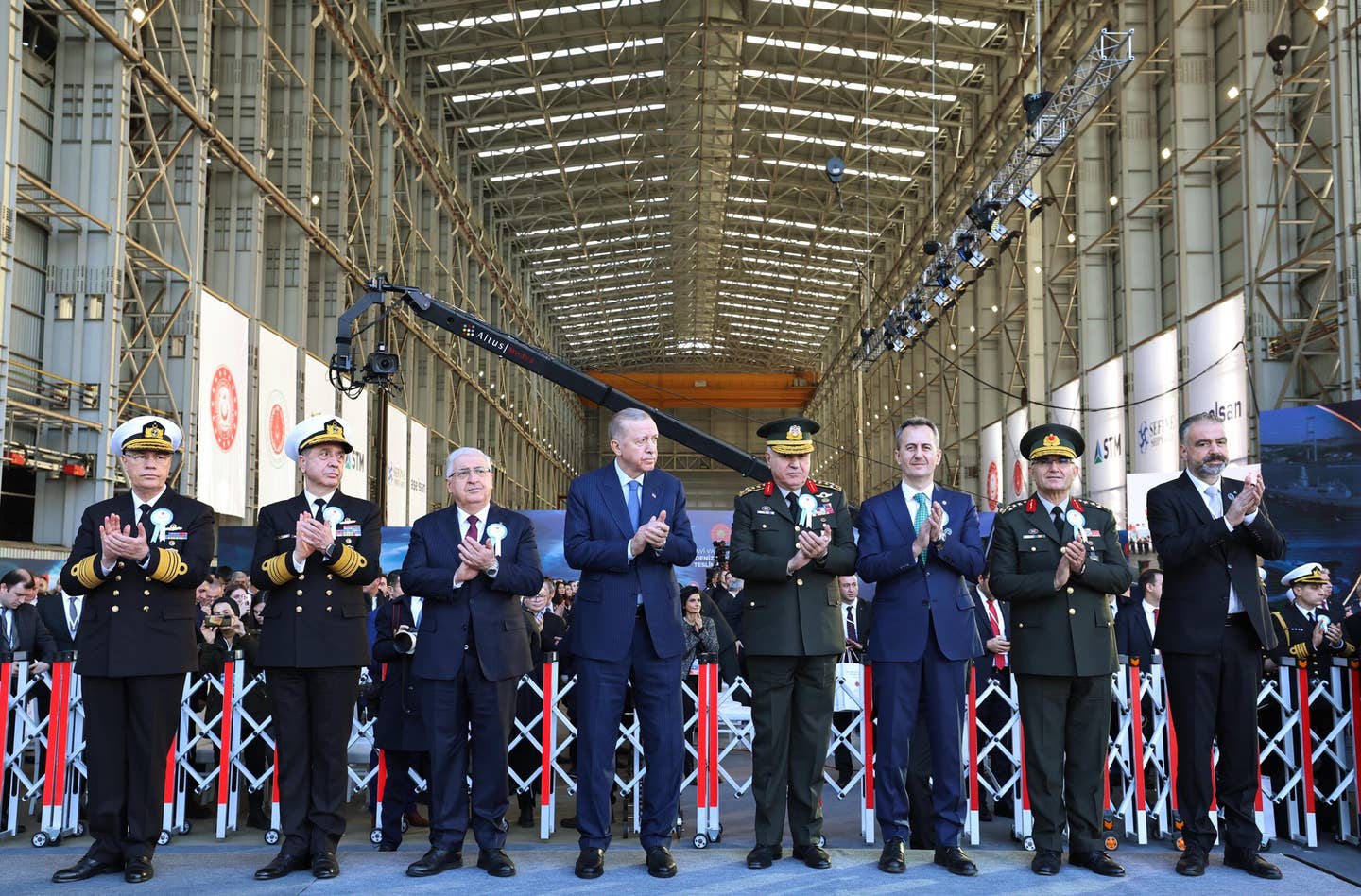
Turkish President Erdogan (C) attends the naval platforms delivery ceremony in Yalova, Turkey, on January 19, 2024. Photo by Turkish Presidency/Murat Cetinmuhurdar/Anadolu via Getty Images
TCG Istanbul was built at the Istanbul Naval Shipyard by the Turkish defense company Savunma Teknolojileri Mühendislik ve Ticaret A.Ş. (known as STM), under the direction of the country's Defence Industry Agency (SSB). A contract for its construction was signed in April 2019, and the vessel was later launched in January 2021. All Istanbul class vessels are the product of Turkey's MILGEM national warship program; created in order to acquire indigenously designed, built, and equipped vessels from corvettes to destroyers.
A further seven sister frigates within the Istanbul class are to be delivered to the Turkish Navy. The second, third, and fourth vessels — named TCG İzmir, İçel, and İzmit — are currently in various phases of construction at the Anadolu Shipyard in Istanbul, the Sedef Shipyard in Istanbul, and the Sefine Shipyard, respectively. Those shipyards collectively form the TAIS shipyard consortium. TAIS and STM were selected to build the three frigates in early 2023.
Construction of the fifth, sixth, and seventh vessels was green-lit during a meeting of the Turkish Defense Industry Executive Committee, with President Erdogan in attendance, in early January this year, bringing the total number of vessels to eight.
While a timeline for the delivery of the latter frigates remains unclear, TCG İzmir, İçel, and İzmit are expected to be built and received by the Turkish Navy within 36 months of TAIS's and STM's selection for their construction. This timeline puts them in service with the Turkish Navy by early 2026. Once they are, along with TCG Istanbul, they will replace the service's four aging German-built Yavuz class frigates; the first of which, TCG Yavuz, began its service with the Turkish navy in July of 1987.
In essence, Istanbul class frigates constitute an enlarged variant of the Ada class anti-submarine corvette, constructed during the first phase of the MILGEM program. Compared to the Ada class frigates' 2,400 ton displacement, the TCG Istanbul has a displacement of 3,100 tons.
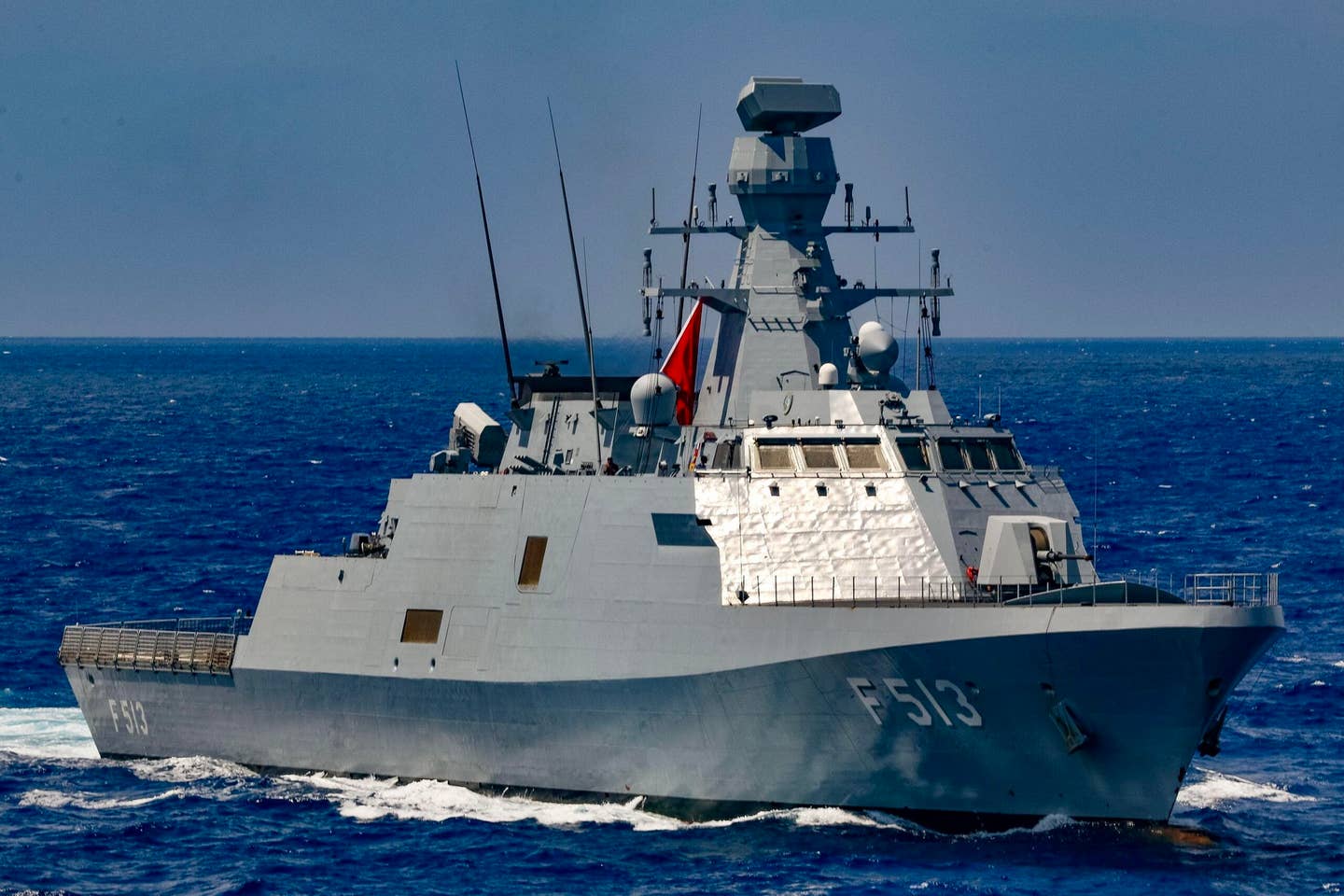
Ada class corvette TCG Burgazada (F-513) pictured in the Mediterranean Sea, August 26, 2020. United States Navy image
This is roughly on par with the four multi-purpose, German-built Barbaros class frigates commissioned from 1997-2000, which have a standard displacement of 3,100 tons and a full displacement of 3,350 tons.
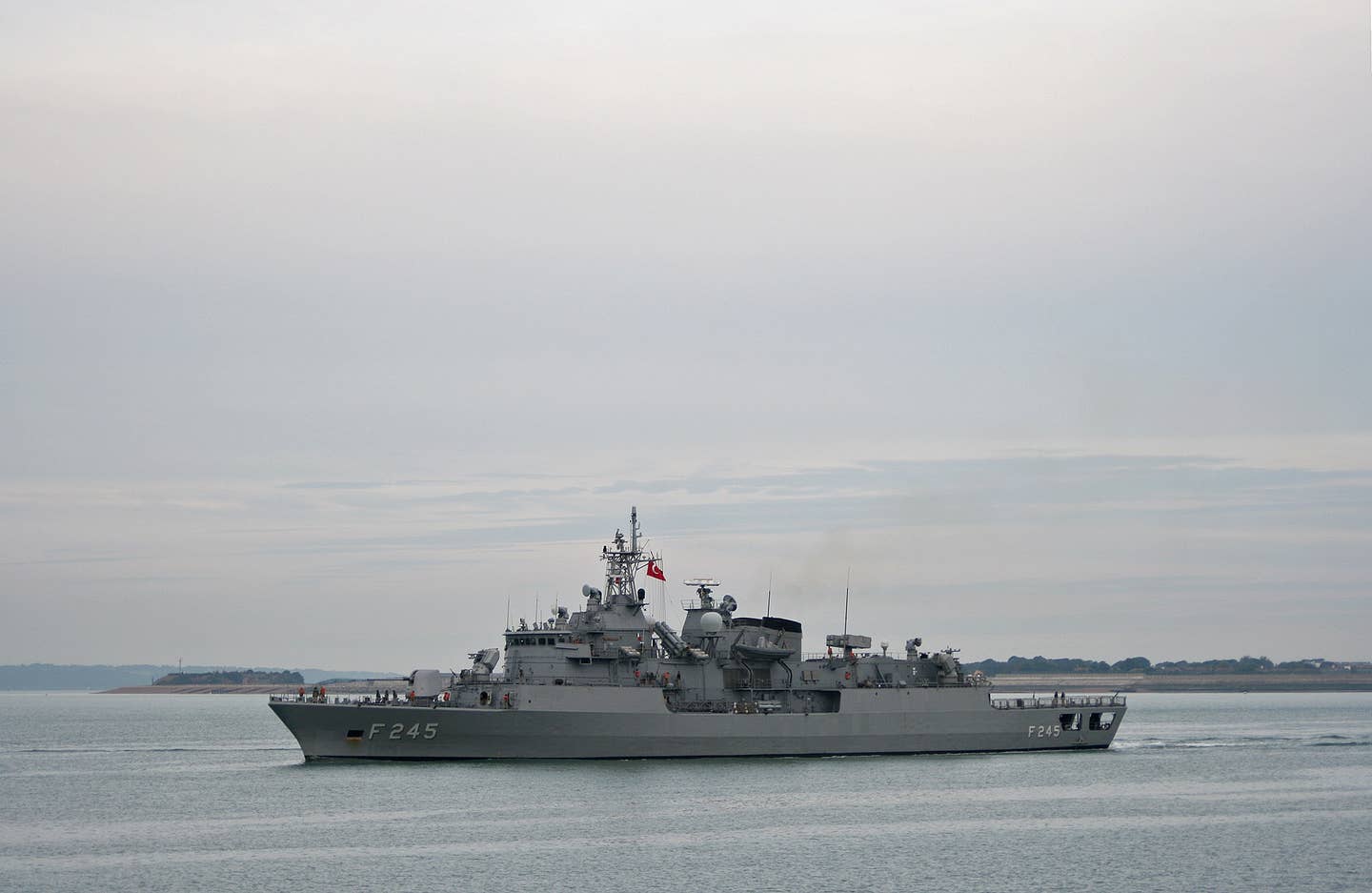
Barbaros class frigate TCG Oruçreis outward bound from Portsmouth Naval Base, U.K., September 21, 2009. Brian Burnell/George Hutchinson via Wikimedia Commons, CC-BY-SA-4.0
TCG Istanbul is also roughly comparable to the first two Barbaros class frigates in terms of overall length and beam, too. TCG Barbaros and TCG Oruçreis measure just shy of 383 feet long, while Istanbul has a standard length of just over 371 feet. The former frigates have beams measuring 49 feet, while Istanbul's beam clocks in at just over 47 feet.
When it comes to propulsion, Turkey's new national frigate features two diesel engines made by the German company MTU Friedrichshafen; a General Electrics LM2500 gas turbine; and two shafts with controllable pitch propellers. It is capable of speeds around 30 knots, and has a 5,700 nautical mile endurance range at a cruising speed of 14 knots.
TCG Istanbul's high proportion of indigenously designed weapons and sensor systems have been identified as a particularly intriguing aspect of the frigate. "TCG Istanbul, MİLGEM İstif-Class Frigates have taken their place among the five most advanced frigates in the world thanks to their design and technologies," General Manager of STM, Ozgur Guleryuz, said during the ceremony on January 19.
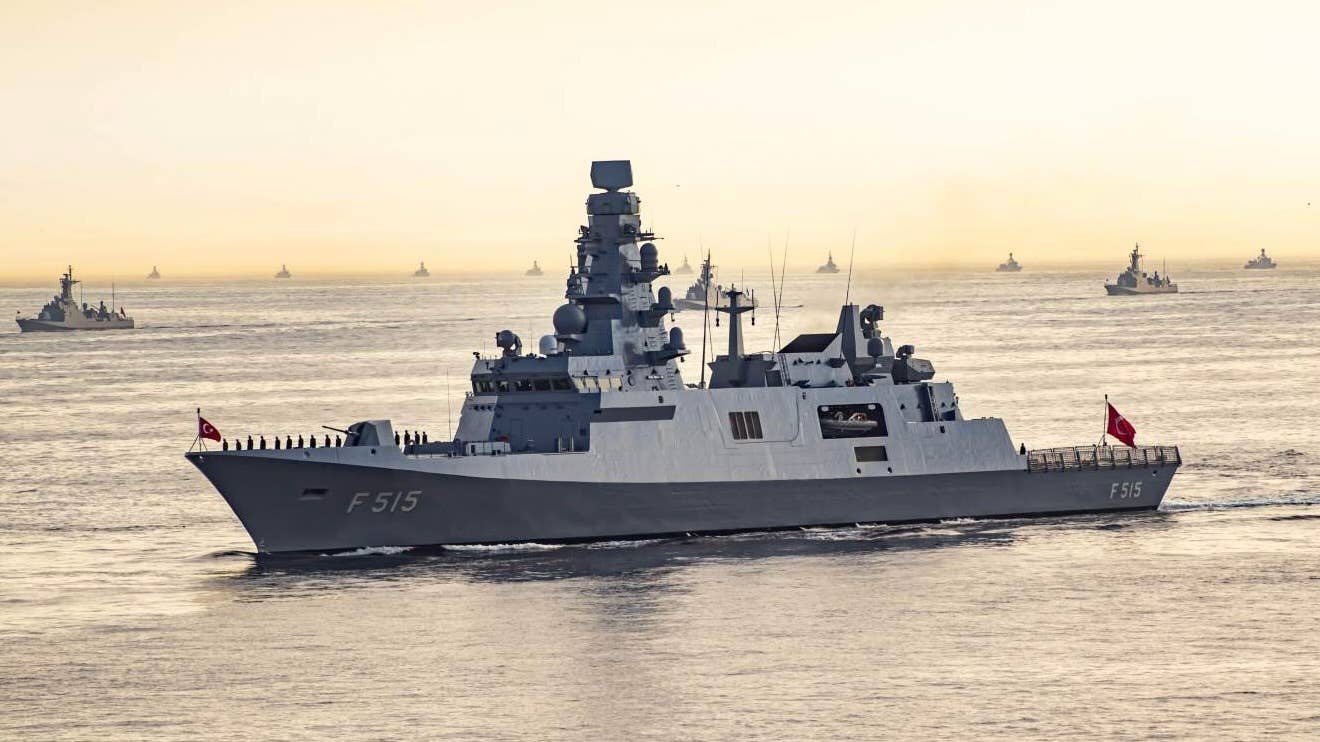
TCG Istanbul at sea. Image via STM
"The targeted localization rate for the Istanbul Frigate was 75 percent — a figure that we managed to increase to 80 percent through our efforts under the leadership of the SSB, and TCG İSTANBUL has thus taken the crown as the warship with the highest localization rate in Türkiye."
In order to better understand its various systems, we reached out to Tayfun Ozberk (@TayfunOzberk), a defense analyst with particular expertise in the Turkish Navy.
"Being the lead-ship in its class, the production of TCG Istanbul presented heightened complexities. It involved the inaugural deployment of numerous weapons and sensors developed by Turkish companies on a naval platform, all integrated for the first time," he said.
"At the beginning of the project, it was planned to outsource some systems. For example, there were to be systems such as Mk 41 vertical launch system (VLS), RAM PDMS [Rolling Airframe Missile Point Defense Missile System]. However, due to the sanctions imposed by the U.S., some changes were made, and instead of these systems, indigenous ones were produced and put on the ship. For example, instead of the Mk 41 VLS, MIDLAS, which is a local VLS, was installed, and instead of RAM, Gokdeniz close-in weapons system (CIWS) was installed."
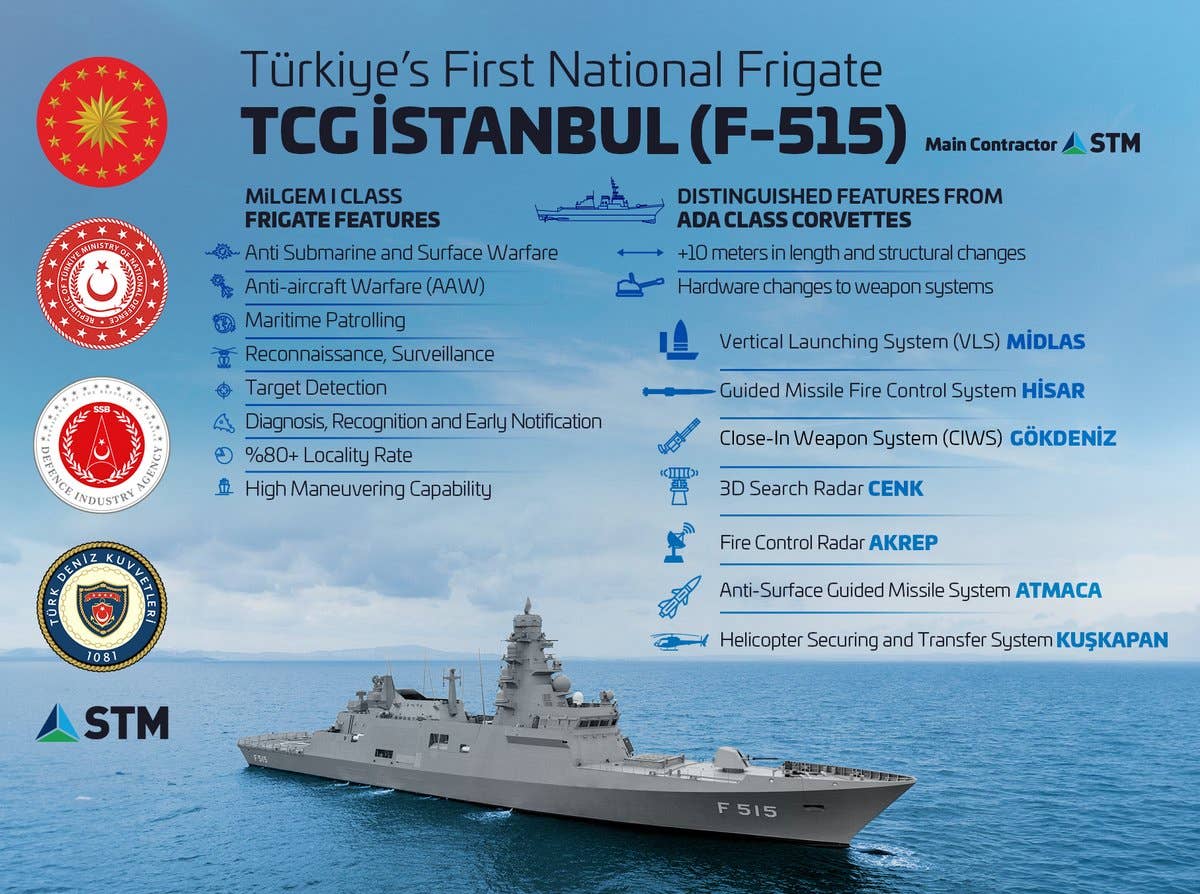
Infographic on TCG Istanbul. STM via Twitter/X
"TCG Istanbul is equipped with the ADVENT combat management system, developed by Havelsan, enabling advanced capabilities in network-centric warfare. Additionally, the Turkish Navy is welcoming the AESA technology with the installation of the CENK-S radar on the ship. With an arsenal of 16 Atmaca anti-ship missiles, TCG Istanbul boasts formidable surface weaponry."
"Although some may criticize the initially limited number of 16 Vertical Launch Systems (VLS), Roketsan is actively working on a quad-pack version for the Hisar-class air defense missiles. This development suggests the potential for an Enhanced Sea Sparrow Missile (ESSM) equivalent system in the near future."
To the rear of the frigate can be found a landing deck and a single hangar capable of housing a Sikorsky S70 Seahawk helicopter. It can also accommodate two rigid-hull inflatable boats (RHIBs). The frigate's crew complement is reportedly around 123.
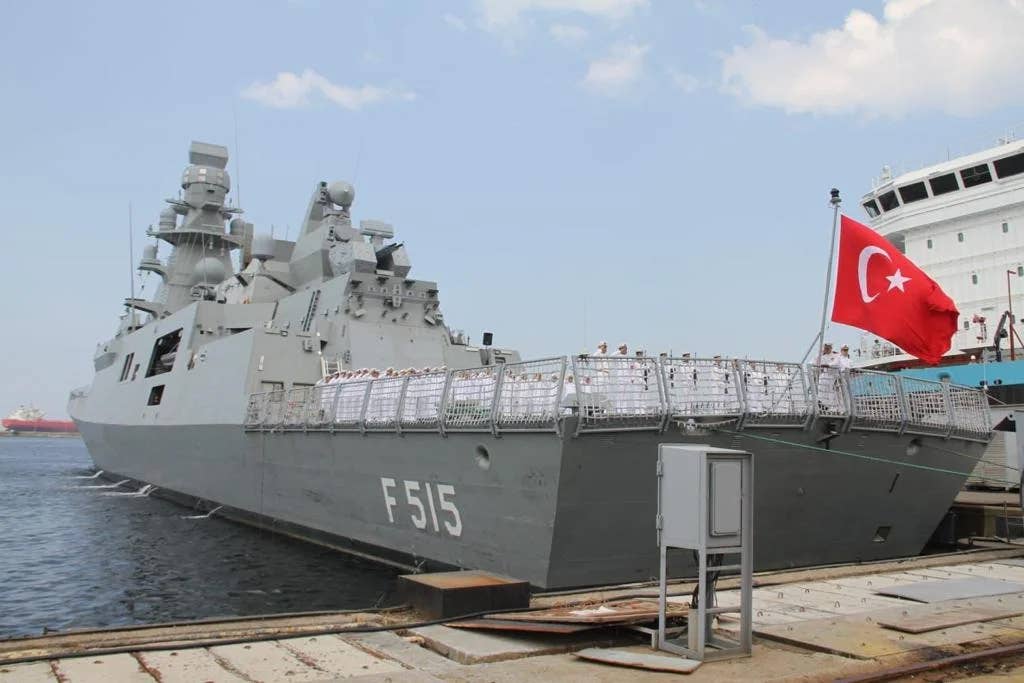
Rear of the frigate, showing the landing deck and hangar. STM
As well as TCG Istanbul, three other naval assets were introduced into service with the Turkish Navy on January 19. TAIS and STM were responsible for delivering two of those; the new-generation fleet oiler TCG Derya and the logistics support ship TCG Ütğm. Arif Ekmekçi.
Construction on TCG Derya began at the Sefine Shipyard in July 2018. The vessel is Turkey's second-largest vessel after the 'drone carrier' amphibious assault ship TCG Anadolu — the former has a displacement of 26,000 tons, while the respective figure for the latter is just under 27,500 tons. Derya will principally be a refueling vessel for the Turkish Navy, and can reportedly carry 10,000 tons of fuel, 750 tons of fresh water and 270 cubic meters of cargo. However, it has also been reported that it will be able to conduct a variety of other mission sets, too, including in a command and control capacity in support of combat operations.
The delivery of TCG Ütğm. Arif Ekmekçi by STM follows the company's handover of the logistics support ship TCG Yzb. Güngör Durmuş to the Turkish Navy in December 2021. STM originally signed a contract with SSB in early 2021 to deliver two logistics ships as part of Turkey's logistics support program, both of which were constructed at the Ada shipyard in Istanbul. TCG Ütğm. Arif Ekmekçi has a displacement of just under 8,500 tons.
In addition, the Sefine Shipyard and defense firm Aselsan handed over its Marlin SİDA uncrewed surface vessel (USV), which was first unveiled during two NATO exercises in September 2022. The USV has a displacement of roughly 21 tons, and measures roughly 49 feet long.
What makes the vessel particularly noteworthy is its electronic warfare (EW) suite, comprising the ASELSAN ARES-2NC R-ES System and ASELSAN AREAS-2NC Compact R-EA System. According to Ismail Demir, previously Turkey's top procurement official, the vessel constitutes the world's "first unmanned surface vessel with electronic warfare capabilities." It's not clear how accurate that claim is, but what is clear is that EW is certainly a focal point for the unique ship. The USV can be variously configured with guided missiles for anti-surface warfare (ASUW) and torpedoes for anti-submarine warfare (ASW).
While the precise cost of the four vessels, including TCG Istanbul, remains unclear, their introduction comes amid significant investment by Ankara to create a modernized, indigenous fleet of vessels.
"We not only carry out the construction and rough workmanship [on ships]," President Erdogan reportedly said of the country's naval production during his speech on January 19. "We are also able to produce the sensors, payloads, weapons and ammunition needed in all ships built locally and domestically… Our naval strength is increasing with our ships. I wholeheartedly believe that we will achieve new successes in the coming period."
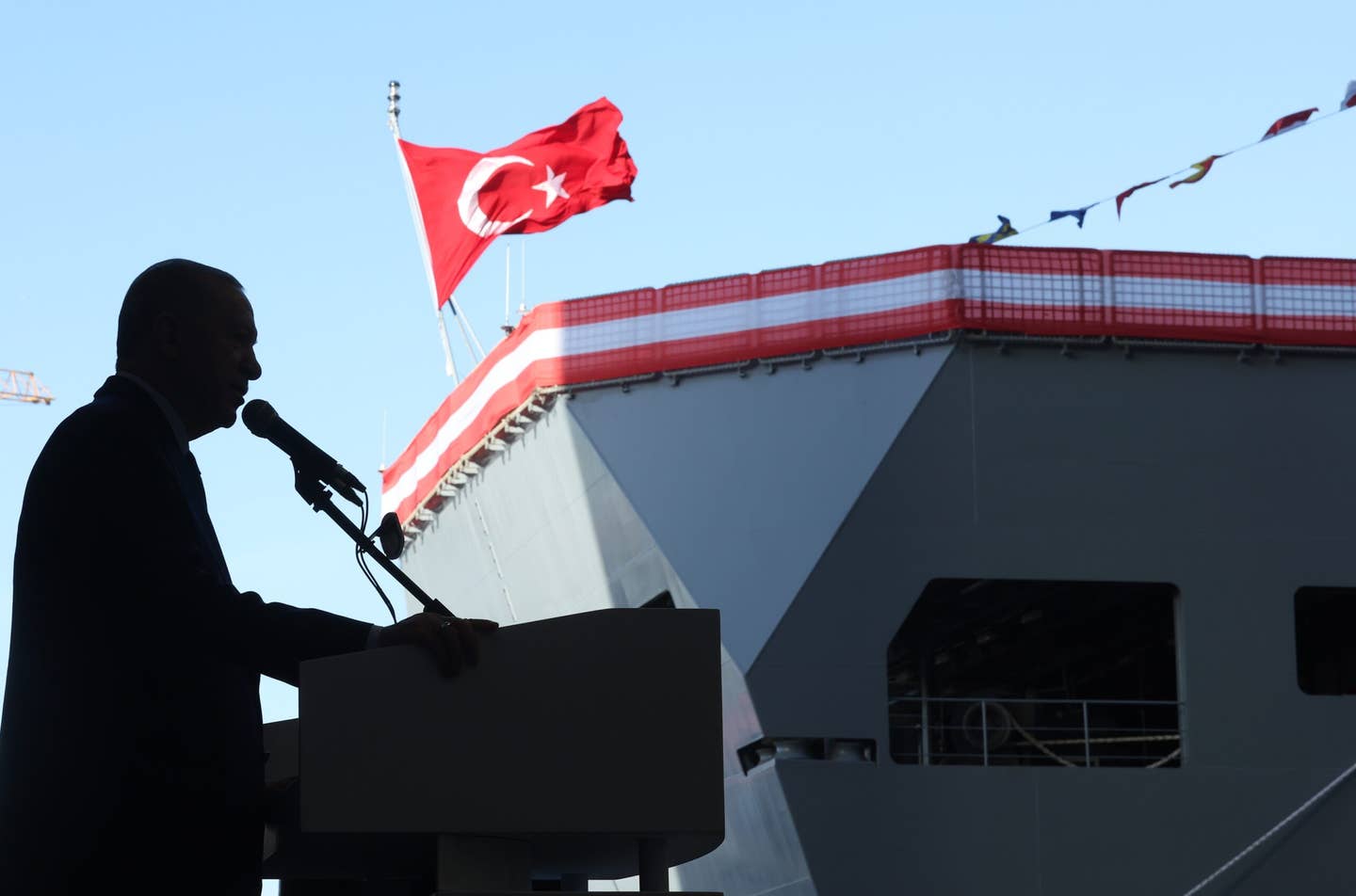
Turkish President Erdogan speaks during the naval platforms delivery ceremony in Yalova, Turkey, on January 19, 2024. Photo by Mustafa Kamaci/Anadolu via Getty Images
The aforementioned amphibious assault ship TCG Anadolu very much represents the jewel in the crown of those ambitions. Entering service in April 2023, the vessel reportedly cost Ankara over $1 billion — the exact figure has not been revealed by Turkish officials. It is capable of fielding a variety of land- as well as air-based systems, including indigenous uncrewed aerial platforms. When it entered service, Erdogan noted that some 70 percent of the ship was built using parts and components made in Turkey; including its weapons, combat systems, radars, infrared search-and-track capability, and electronic warfare suite.
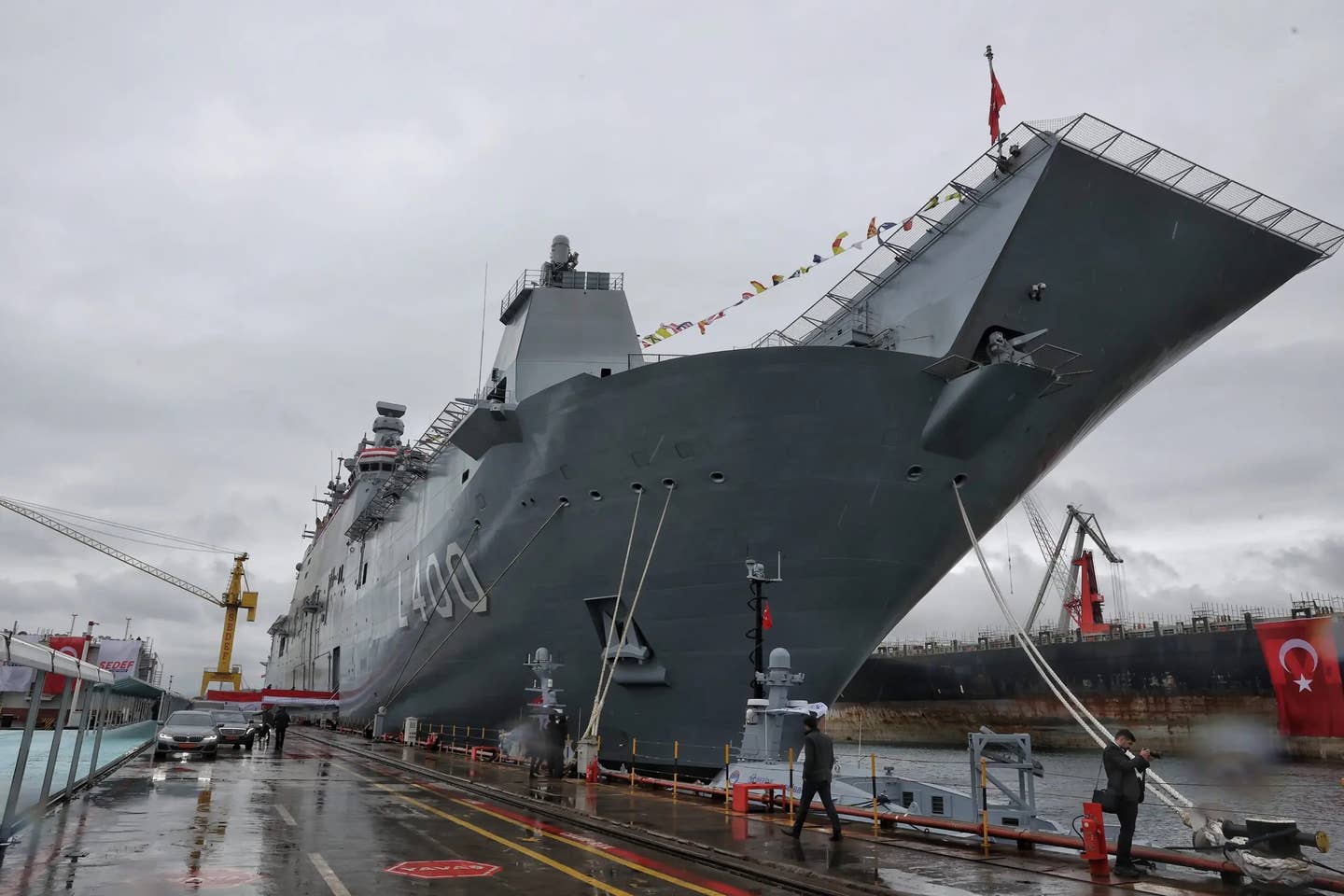
The TCG Anadolu on April 10, 2023 in Tuzla, Istanbul. Photo by Ozan Guzelce via Getty Images
More broadly, Ankara has committed to a sharp rise in defense spending in 2024 to accommodate aims for greater domestic production of its future defense capabilities. It is set to allocate $40 billion to its defense budget for 2024 compared to $16 billion for 2023, a rise of some 150 percent, Reuters reports. On top of this, the country also aims to increase self-sufficiency within its defense industry by five percent in 2024 compared to 2023; rising from 80 percent to 85 percent year-on-year.
TCG Istanbul serves as yet another example of Turkey's push for independence in military hardware procurement that is being fueled by a massive modernization effort. With many of these efforts now coalescing, the Turkish armed services is beginning to look remarkably different than it did just half a decade ago.

 www.thedrive.com
www.thedrive.com
Turkey’s First Domestically-Produced Frigate Has Entered Service
TCG Istanbul represents a significant achievement for Turkey’s shipbuilding industry, which aims to become ever more self-reliant.By Oliver Parken| PUBLISHED Jan 23, 2024 8:34 PM EST
On January 19, Turkey's first-in-class frigate TCG Istanbul entered into service with the country's Navy during a ceremony held at Sefine Shipyard in Yalova Province, northwest Turkey. The introduction of the vessel marks a significant moment for the country, given that it constitutes Turkey's first nationally-developed frigate. This also comes amid a relatively remarkable modernization effort based on locally sourced hardware that spans the services within Turkey's armed forces in recent years.
The Istanbul class is designed to perform a wide range of missions for the Turkish Navy, including everything from surveillance to anti-surface, anti-air, and anti-submarine warfare. What's most notable about TCG Istanbul in particular is its high percentage of indigenously built components, particularly in terms of its armament and electronic warfare and sensor suites. In all, some 220 Turkish companies participated in constructing the frigate, which included 80 subcontractors working on the delivery of more than 150 systems, Naval News reports.
In attendance for the ceremony was Turkish President Recep Tayyip Erdogan, as well as a number of high-profile guests including Turkey's Minister of National Defense, Yaşar Güler, and Admiral Ercüment Tatlıoğlu, commander of the Turkish Naval Forces.

Turkish President Erdogan (C) attends the naval platforms delivery ceremony in Yalova, Turkey, on January 19, 2024. Photo by Turkish Presidency/Murat Cetinmuhurdar/Anadolu via Getty Images
TCG Istanbul was built at the Istanbul Naval Shipyard by the Turkish defense company Savunma Teknolojileri Mühendislik ve Ticaret A.Ş. (known as STM), under the direction of the country's Defence Industry Agency (SSB). A contract for its construction was signed in April 2019, and the vessel was later launched in January 2021. All Istanbul class vessels are the product of Turkey's MILGEM national warship program; created in order to acquire indigenously designed, built, and equipped vessels from corvettes to destroyers.
A further seven sister frigates within the Istanbul class are to be delivered to the Turkish Navy. The second, third, and fourth vessels — named TCG İzmir, İçel, and İzmit — are currently in various phases of construction at the Anadolu Shipyard in Istanbul, the Sedef Shipyard in Istanbul, and the Sefine Shipyard, respectively. Those shipyards collectively form the TAIS shipyard consortium. TAIS and STM were selected to build the three frigates in early 2023.
Construction of the fifth, sixth, and seventh vessels was green-lit during a meeting of the Turkish Defense Industry Executive Committee, with President Erdogan in attendance, in early January this year, bringing the total number of vessels to eight.
While a timeline for the delivery of the latter frigates remains unclear, TCG İzmir, İçel, and İzmit are expected to be built and received by the Turkish Navy within 36 months of TAIS's and STM's selection for their construction. This timeline puts them in service with the Turkish Navy by early 2026. Once they are, along with TCG Istanbul, they will replace the service's four aging German-built Yavuz class frigates; the first of which, TCG Yavuz, began its service with the Turkish navy in July of 1987.
In essence, Istanbul class frigates constitute an enlarged variant of the Ada class anti-submarine corvette, constructed during the first phase of the MILGEM program. Compared to the Ada class frigates' 2,400 ton displacement, the TCG Istanbul has a displacement of 3,100 tons.

Ada class corvette TCG Burgazada (F-513) pictured in the Mediterranean Sea, August 26, 2020. United States Navy image
This is roughly on par with the four multi-purpose, German-built Barbaros class frigates commissioned from 1997-2000, which have a standard displacement of 3,100 tons and a full displacement of 3,350 tons.

Barbaros class frigate TCG Oruçreis outward bound from Portsmouth Naval Base, U.K., September 21, 2009. Brian Burnell/George Hutchinson via Wikimedia Commons, CC-BY-SA-4.0
TCG Istanbul is also roughly comparable to the first two Barbaros class frigates in terms of overall length and beam, too. TCG Barbaros and TCG Oruçreis measure just shy of 383 feet long, while Istanbul has a standard length of just over 371 feet. The former frigates have beams measuring 49 feet, while Istanbul's beam clocks in at just over 47 feet.
When it comes to propulsion, Turkey's new national frigate features two diesel engines made by the German company MTU Friedrichshafen; a General Electrics LM2500 gas turbine; and two shafts with controllable pitch propellers. It is capable of speeds around 30 knots, and has a 5,700 nautical mile endurance range at a cruising speed of 14 knots.
TCG Istanbul's high proportion of indigenously designed weapons and sensor systems have been identified as a particularly intriguing aspect of the frigate. "TCG Istanbul, MİLGEM İstif-Class Frigates have taken their place among the five most advanced frigates in the world thanks to their design and technologies," General Manager of STM, Ozgur Guleryuz, said during the ceremony on January 19.

TCG Istanbul at sea. Image via STM
"The targeted localization rate for the Istanbul Frigate was 75 percent — a figure that we managed to increase to 80 percent through our efforts under the leadership of the SSB, and TCG İSTANBUL has thus taken the crown as the warship with the highest localization rate in Türkiye."
In order to better understand its various systems, we reached out to Tayfun Ozberk (@TayfunOzberk), a defense analyst with particular expertise in the Turkish Navy.
"Being the lead-ship in its class, the production of TCG Istanbul presented heightened complexities. It involved the inaugural deployment of numerous weapons and sensors developed by Turkish companies on a naval platform, all integrated for the first time," he said.
"At the beginning of the project, it was planned to outsource some systems. For example, there were to be systems such as Mk 41 vertical launch system (VLS), RAM PDMS [Rolling Airframe Missile Point Defense Missile System]. However, due to the sanctions imposed by the U.S., some changes were made, and instead of these systems, indigenous ones were produced and put on the ship. For example, instead of the Mk 41 VLS, MIDLAS, which is a local VLS, was installed, and instead of RAM, Gokdeniz close-in weapons system (CIWS) was installed."

Infographic on TCG Istanbul. STM via Twitter/X
"TCG Istanbul is equipped with the ADVENT combat management system, developed by Havelsan, enabling advanced capabilities in network-centric warfare. Additionally, the Turkish Navy is welcoming the AESA technology with the installation of the CENK-S radar on the ship. With an arsenal of 16 Atmaca anti-ship missiles, TCG Istanbul boasts formidable surface weaponry."
"Although some may criticize the initially limited number of 16 Vertical Launch Systems (VLS), Roketsan is actively working on a quad-pack version for the Hisar-class air defense missiles. This development suggests the potential for an Enhanced Sea Sparrow Missile (ESSM) equivalent system in the near future."
To the rear of the frigate can be found a landing deck and a single hangar capable of housing a Sikorsky S70 Seahawk helicopter. It can also accommodate two rigid-hull inflatable boats (RHIBs). The frigate's crew complement is reportedly around 123.

Rear of the frigate, showing the landing deck and hangar. STM
As well as TCG Istanbul, three other naval assets were introduced into service with the Turkish Navy on January 19. TAIS and STM were responsible for delivering two of those; the new-generation fleet oiler TCG Derya and the logistics support ship TCG Ütğm. Arif Ekmekçi.
Construction on TCG Derya began at the Sefine Shipyard in July 2018. The vessel is Turkey's second-largest vessel after the 'drone carrier' amphibious assault ship TCG Anadolu — the former has a displacement of 26,000 tons, while the respective figure for the latter is just under 27,500 tons. Derya will principally be a refueling vessel for the Turkish Navy, and can reportedly carry 10,000 tons of fuel, 750 tons of fresh water and 270 cubic meters of cargo. However, it has also been reported that it will be able to conduct a variety of other mission sets, too, including in a command and control capacity in support of combat operations.
The delivery of TCG Ütğm. Arif Ekmekçi by STM follows the company's handover of the logistics support ship TCG Yzb. Güngör Durmuş to the Turkish Navy in December 2021. STM originally signed a contract with SSB in early 2021 to deliver two logistics ships as part of Turkey's logistics support program, both of which were constructed at the Ada shipyard in Istanbul. TCG Ütğm. Arif Ekmekçi has a displacement of just under 8,500 tons.
In addition, the Sefine Shipyard and defense firm Aselsan handed over its Marlin SİDA uncrewed surface vessel (USV), which was first unveiled during two NATO exercises in September 2022. The USV has a displacement of roughly 21 tons, and measures roughly 49 feet long.
What makes the vessel particularly noteworthy is its electronic warfare (EW) suite, comprising the ASELSAN ARES-2NC R-ES System and ASELSAN AREAS-2NC Compact R-EA System. According to Ismail Demir, previously Turkey's top procurement official, the vessel constitutes the world's "first unmanned surface vessel with electronic warfare capabilities." It's not clear how accurate that claim is, but what is clear is that EW is certainly a focal point for the unique ship. The USV can be variously configured with guided missiles for anti-surface warfare (ASUW) and torpedoes for anti-submarine warfare (ASW).
While the precise cost of the four vessels, including TCG Istanbul, remains unclear, their introduction comes amid significant investment by Ankara to create a modernized, indigenous fleet of vessels.
"We not only carry out the construction and rough workmanship [on ships]," President Erdogan reportedly said of the country's naval production during his speech on January 19. "We are also able to produce the sensors, payloads, weapons and ammunition needed in all ships built locally and domestically… Our naval strength is increasing with our ships. I wholeheartedly believe that we will achieve new successes in the coming period."

Turkish President Erdogan speaks during the naval platforms delivery ceremony in Yalova, Turkey, on January 19, 2024. Photo by Mustafa Kamaci/Anadolu via Getty Images
The aforementioned amphibious assault ship TCG Anadolu very much represents the jewel in the crown of those ambitions. Entering service in April 2023, the vessel reportedly cost Ankara over $1 billion — the exact figure has not been revealed by Turkish officials. It is capable of fielding a variety of land- as well as air-based systems, including indigenous uncrewed aerial platforms. When it entered service, Erdogan noted that some 70 percent of the ship was built using parts and components made in Turkey; including its weapons, combat systems, radars, infrared search-and-track capability, and electronic warfare suite.

The TCG Anadolu on April 10, 2023 in Tuzla, Istanbul. Photo by Ozan Guzelce via Getty Images
More broadly, Ankara has committed to a sharp rise in defense spending in 2024 to accommodate aims for greater domestic production of its future defense capabilities. It is set to allocate $40 billion to its defense budget for 2024 compared to $16 billion for 2023, a rise of some 150 percent, Reuters reports. On top of this, the country also aims to increase self-sufficiency within its defense industry by five percent in 2024 compared to 2023; rising from 80 percent to 85 percent year-on-year.
TCG Istanbul serves as yet another example of Turkey's push for independence in military hardware procurement that is being fueled by a massive modernization effort. With many of these efforts now coalescing, the Turkish armed services is beginning to look remarkably different than it did just half a decade ago.

Turkey's First Domestically-Produced Frigate Has Entered Service
TCG Istanbul represents a significant achievement for Turkey's shipbuilding industry, which aims to become ever more self-reliant.
Last edited:
Planned features of the domestic aircraft carrier: -
285 meters full length
- 68 meters wide
- 60 thousand tons displacement
- 25 knots speed
- COGAG drive
- STOBAR plane takeoff

285 meters full length
- 68 meters wide
- 60 thousand tons displacement
- 25 knots speed
- COGAG drive
- STOBAR plane takeoff
The front ramp and sides need a bit more consideration. Could put some elevators around.Planned features of the domestic aircraft carrier: -
285 meters full length
- 68 meters wide
- 60 thousand tons displacement
- 25 knots speed
- COGAG drive
- STOBAR plane takeoff
It was never called a destroyer. TF, Turkish Frigate.
So many British lines from QE. Don't know how much sense that makes when Brits are thinking about modifying QE heavily.Planned features of the domestic aircraft carrier: -
285 meters full length
- 68 meters wide
- 60 thousand tons displacement
- 25 knots speed
- COGAG drive
- STOBAR plane takeoff
View attachment 65664
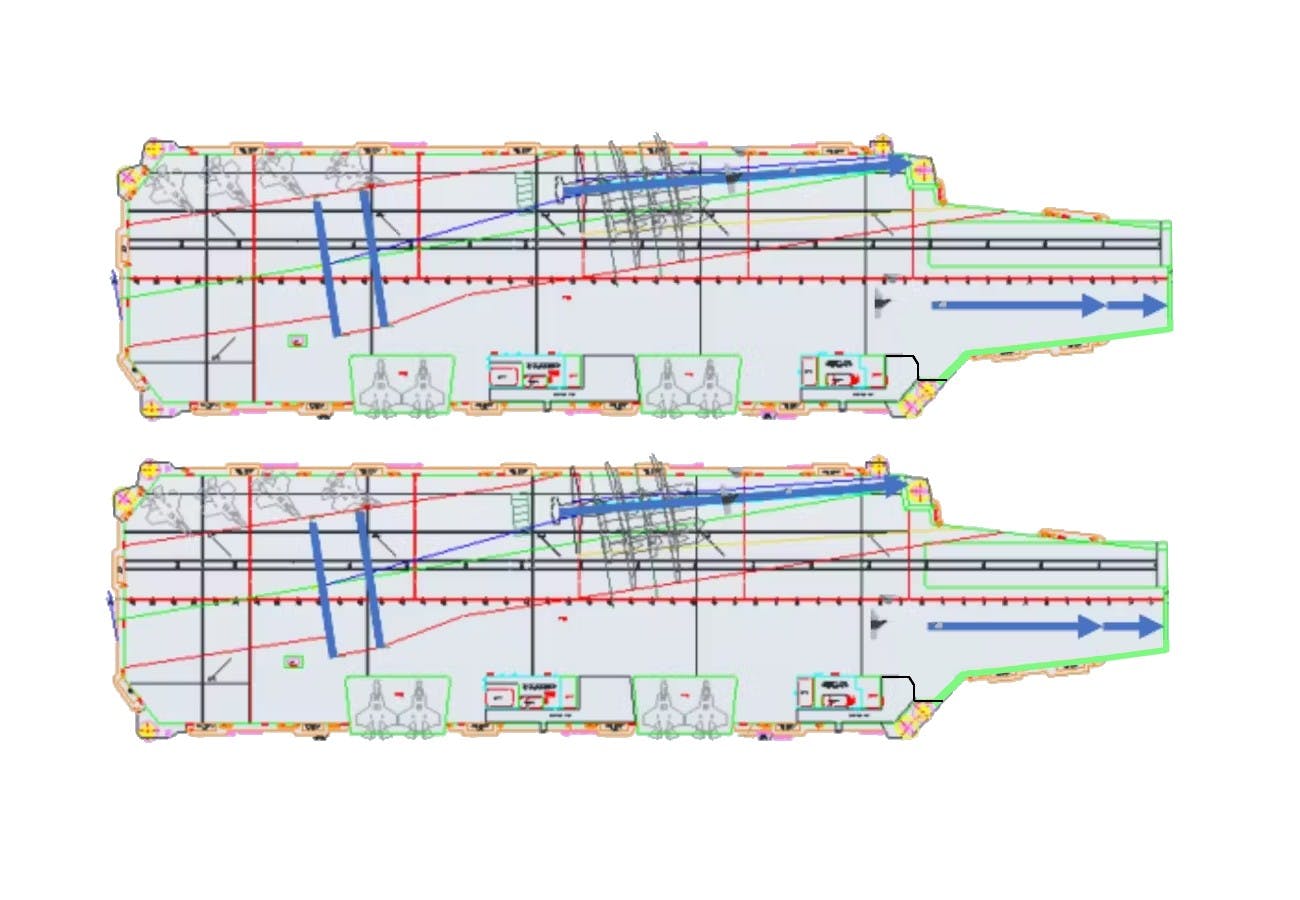
Project Ark Royal – Plans for angled decks and drones
As part of Project Ark Royal, significant upgrades to the Queen Elizabeth-class aircraft carriers would be undertaken.
 ukdefencejournal.org.uk
ukdefencejournal.org.uk
And I'll point the elephant. Kaan with STOL... QE as a design works only thanks to F-35B and STOVL. So weird this.
--
Some of the figures given also pretty closely match that of QE. 65 tons of QE to 60 tons. 280 meters length of QE to 285m. 25+kts for both, 70m beam of QE to 68m.
Last edited:
Kuznetsov and the copies etc. Are being used with migs and India is testing Rafale and F18. However afaik their payload is limited. Naval KAAN is too far fetched, even US Navy cancelled F22 naval variant. This is better for drones, Hürjet and maybe a lighter aircraft. Big jets just require longer runways.It was never called a destroyer. TF, Turkish Frigate.
So many British lines from QE. Don't know how much sense that makes when Brits are thinking about modifying QE heavily.

Project Ark Royal – Plans for angled decks and drones
As part of Project Ark Royal, significant upgrades to the Queen Elizabeth-class aircraft carriers would be undertaken.ukdefencejournal.org.uk
And I'll point the elephant. Kaan with STOL... QE as a design works only thanks to F-35B and STOVL. So weird this.
Baryshx
Contributor
We can say that the naval aircraft version of the Hürjet will definitely come.Planned features of the domestic aircraft carrier: -
285 meters full length
- 68 meters wide
- 60 thousand tons displacement
- 25 knots speed
- COGAG drive
- STOBAR plane takeoff
View attachment 65664
Anything lighter than Hürjet would be completely meaningless, even Hürjet itself is too light imo to worth the trouble of turning naval.Hürjet and maybe a lighter aircraft.
I mean lighter than KaanAnything lighter than Hürjet would be completely meaningless, even Hürjet itself is too light imo to worth the trouble of turning naval.
Oh yeah, that's for sure. Lighter than Kaan, heavier than Hürjet would be the butter zone, which is a problem because we have nothing like that, not even a mention of anything like that.I mean lighter than Kaan
Baryshx
Contributor
With F414 engine instead of F404 and some modifications, it can be a very good naval aircraft. In fact, it can be with F404.Anything lighter than Hürjet would be completely meaningless, even Hürjet itself is too light imo to worth the trouble of turning naval.
With F414 engine instead of F404 and some modifications, it can be a very good naval aircraft. In fact, it can be with F404.
Can we get F404 for anything armed let alone naval flghter jet?
I think we should really consider either one engine lighter Kaan(which uses national engine) or develeoping a ~20000lbs engine which we can use both Hurjet and naval fighter jet(either bigger two engined Hurjet or lighter two engined Kaan)
And I know both of above options doesn't seem realistic in the near future but neither does a full fledged carrier(considering we don't have any real option for aircraft) so who knows.
But if we really going to do this, I think going with Kızılelma/Anka till we develop suitable aircraft is the realistic option. We should expect to use this carrier without a manned fighter jet for a while and make our plans around this.
I don't believe a plane that doesn't even have payload of 3000kg would make a good naval aircraft since those planes have to make every sortie count. And as @Fairon pointed out, there is no guarantee that we would be allowed to use F404 in an armed plane, let alone a naval one and we don't even know if they would consider selling F414 to us. And we don't have a domestic engine that would fall into thrust category of Hürjet.With F414 engine instead of F404 and some modifications, it can be a very good naval aircraft. In fact, it can be with F404.
I would personally go with this route, not just because it would make a naval Kaan more feasible, but also we can offer that as an export option as that would be cheaper than Kaan.I think we should really consider either one engine lighter Kaan
Some notable points about National Aircraft Carrier:
1) Seeing KAAN-like 5th generation warplanes on board: A sign that the ship will not only be used for unmanned vehicles.
2)Launch pad + STOBAR: It means aircraft that can carry less payload compared to CATOBAR. Can the design change?
credit: Turan Oguz
@TyrannosurusRex

1) Seeing KAAN-like 5th generation warplanes on board: A sign that the ship will not only be used for unmanned vehicles.
2)Launch pad + STOBAR: It means aircraft that can carry less payload compared to CATOBAR. Can the design change?
credit: Turan Oguz
@TyrannosurusRex
Last edited:
On a 60k ton full scale aircraft carrier, I would expect to see a design that focuses on sortie density, such as an angled flight deck for simultaneous landing operations, and multiple flight lines that would allow more aircraft to prepare for flight at the same time...
In fact, the illustration shown as a conceptual design looks like a very raw work. Especially in the jump ramp part, the drawing is not even complete... I don't think it would be right to consider this as the final design idea. I hope the deck layout will improve. I also wish the ship had a section on board for its own air defense systems.
In fact, the illustration shown as a conceptual design looks like a very raw work. Especially in the jump ramp part, the drawing is not even complete... I don't think it would be right to consider this as the final design idea. I hope the deck layout will improve. I also wish the ship had a section on board for its own air defense systems.
Last edited:
Baryshx
Contributor
Yes, I'm of the same opinion. It's a bit disappointing in that respect. It's like an outdated design...On a 60k ton full scale aircraft carrier, I would expect to see a design that focuses on sortie density, such as an angled flight deck for simultaneous landing operations, and multiple flight lines that would allow more aircraft to prepare for flight at the same time...
In fact, the illustration shown as a conceptual design looks like a very raw work. Especially in the jump ramp part, the drawing is not even complete... I don't think it would be right to consider this as the final design idea. I hope the deck layout will improve. I also wish the ship had a section on board for its own air defense systems.
I'm waiting for an angled deck where 2-3 planes can take off at the same time.








